
Paradise by the bioluminescent light
Large cities spend millions on energy for city lights annually. A metropolis like
Barcelona, with over one and a half million inhabitants, spends ten million euros each
year solely on the maintenance of streetlights. On top of that there are the electrical
costs to light up the city (1). Consider the costs of domestic lighting in such a city; we do
not have to tell you this adds up to a lot of money! Besides, such a demand for energy is
a burden on the environment in the form of extra CO2 emissions. If it is up to certain
bioengineers, part of these problems are soon to be history. They think this dilemma will
partly be solved by lighting up our future cities with organisms that can produce their
own light. Since these organisms do not need any electricity, they might be more eco-
friendly than their electrical equivalents. But how are organisms able to produce light? In
short the production of light is caused by a chemical reaction inside the organism, called
bioluminescence(2). In addition to illuminating the environment, bioluminescent
organisms can carry out tasks like information transfer and serve educational,
entertainment and aesthetic purposes. For example, bioluminescent unicellular
organisms can be used as a night light, while glowing bacteria can be used as an
emergency exit sign. However, before you can understand these practical uses, it is
important to know how this light is produced inside the cells of these organisms. Since
this feature can be found in many different organisms like earthworms, millipedes and
marine species, it will be interesting to see how bioluminescence has come to be and
what uses these organisms have for it.
The biological mechanism
First, let us take a look at the underlying mechanism of bioluminescence. Since organisms do
not have light bulbs in their cells, there must be another mechanism that causes them to glow.
This mechanism relies on a chemical reaction, involving certain proteins, light producing
compounds and other molecules. As you will read in the subsequent section, there are
numerous occasions on which luminescence evolved in the past. Because of this, there is a
wide variety of the light producing compounds and enzymes, which may differ from species to
species(2). The light producing compounds have been given the general name 'luciferins',
while the enzymes are called 'luciferases'. Luciferin pigment molecules are able to bind O2 and
this reaction is catalysed by the luciferase enzymes. Luciferase catalyses the interaction
between luciferin and O2 to form oxyluciferin, thereby producing light in the form of a photon
and CO2(3). After the oxyluciferin is formed, the cell will reuse it by converting it back to
luciferin, which requires energy. The reaction is depicted in figure 1.
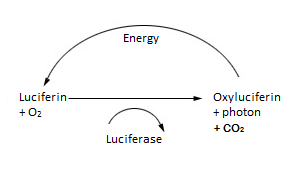
Figure 1:
The general molecular pathway of bioluminescence. Luciferin and O2 are bound
together by the luciferase, after which oxyluciferin and a photon are formed. The pathway for
recycling the end products is also shown.
Altered from source by Sanne van Kuijk.
Colours
If we look at the wide variety of bioluminescent species, we see that bioluminescence comes in
many different colours. The colour is determined by the type of luciferin that is used and the
amount of energy released during the chemical reaction(3). The colour is usually an adaptation
to the environment in which the organism lives. Blue light is the most common colour, because
this wavelength travels the greatest distance through water, relatively speaking. This is not a
coincidence, since most forms of bioluminescence evolved in watery environments, as we shall
see later on. After blue, green is the most occurring colour, which is better visible in coastal
waters. Other colours like yellow, red, orange and violet are less common and their function has
not yet been discovered(4). Sometimes environmental conditions like pH and temperature can
influence colour within a species(5).
Presence of bioluminescence
Many people regard bioluminescence as a rare phenomenon, but it is actually quite widespread.
Furthermore, not only bioluminescent organisms emit light; it probably occurs in all cells of any
organism as a by-product of oxidation and metabolic reactions. This light is so weak that it
cannot be advantageous in itself, but it is possibly the basis of actual bioluminescence(6). It is a
common misconception that many of the known luminescent animals get their luminescence
from a symbiotic relationship with bacteria. Most of the time luminescence is a product of the
organisms themselves(2).
Many marine organisms can produce light and bioluminescence is the primary source of light in
most of the deep ocean(2). 80% of the known genera that contain bioluminescent species are
marine(4). In freshwater, luminescence is present in some insect larvae and one species of
freshwater limpets(2). On land, most luminescent animals are insects. The most obvious
example are fireflies(2,7). Other examples are some species of fungi, centipedes and
millipedes, snails, earthworms, beetles and insects like springtails and flies. Notably,
luminescence is not found in flowering plants and terrestrial amphibians, birds and mammals.
There are a lot more marine organisms that can emit light than there are terrestrial organisms.
This is because the ocean has several aspects that are favourable for the development of
bioluminescence(2). Firstly, the environmental conditions in the ocean are relatively stable. This
means that natural selection can favour the bioluminescent trait for a longer period of time,
since evolution is partially dependent on environmental pressures(2,6). Additionally, the water
in oceans is much clearer than the turbid water in rivers and lakes, so light will travel a long way.
Thirdly, the deep ocean is almost completely dark(2). As sunlight filters through water, it
diminishes a tenfold every 75 meter of descent. Below 1000 meters, all visible light is filtered out
(4). You can imagine the light will have a lot more impact there than it would have in shallower
waters.
Origin of bioluminescence
In general there are two hypotheses regarding the evolution of bioluminescence in marine
organisms. Natural selection acted either on the light emitting molecule luciferin, or on the
enzyme luciferase(4,7).
In the first case, luciferins functioned as antioxidants, molecules highly reactive with oxygen that
inhibit the oxidation of other molecules. Their original function was probably the detoxification of
reactive oxygen species (ROS). ROS are chemically reactive molecules that contain oxygen.
ROS are a natural by-product of oxygen reactions. ROS levels can increase during times of
environmental stress, which can cause significant damage inside cells. At one point, marine
organisms capable of sight started to live in deeper layers of the ocean to escape detection by
vision dependent predators(4,6,7). Since there is less light available, there is less
photosynthetic oxygen. So in the deep ocean, these animals experienced less oxidative stress
(6). Together with the light, UV radiation is filtered out by the water so it cannot have a ROS
inducing effect on cells. Due to the lack of oxygen, deep sea organisms have a reduced
metabolic activity and therefore a decreased endogenous ROS production. All of these factors
diminished natural selection on the antioxidant function of the luciferin and shifted it to the
bioluminescent function (4,6). It has been reported that the firefly luciferin is also able to protect
cells against oxidative stress, which implies that this luciferin originated in the same way as in
marine organisms. In what conditions this happened is still unclear(7).
In the second case, natural selection acted on oxygenases, enzymes that oxidize molecules,
thereby turning them in the luciferases we know now. Studies show that luciferases are
phylogenetically different from oxygenases and there were no homologies found between
them(6). But even though this hypothesis has been questioned by evidence, there is still some
support for this interpretation. Take for example the octopod Stauroteuthis syrtensis. There is
evidence that suggests that the octopod originally had suckers on its tentacles, which served
purposes like movement or catching prey. During evolution these suckers became
bioluminescent and lost their adhesive properties. A probable explanation for the change of
function is that before these suckers were bioluminescent, a reaction involving a metabolic
enzyme took place. Light might have been emitted as a by-product and over time selective
pressures favoured the light emitting property, rather than the original function of the luciferases
and eventually the suckers. The original enzyme lost its initial function as oxygenase and gained
a new one, as luciferase(4).
Independent origins
It is hard to calculate how many times bioluminescence has evolved independently. This is
because it is difficult to define what the meaning of independent origin is. For bacterial
symbionts, the feature might have evolved only once, but each of the organisms using these
microbes may have developed specialized organs to host and maintain the bacteria
independently(2). Furthermore, the female Linophryne polypogon, a deep-sea anglerfish, has
two different bioluminescent systems: a symbiosis with bacteria in the lure and an innate system
in the chin barbell (4)(Figure 2). A rough estimate is that luminescence has evolved
independently between forty and fifty times among organisms that exist today(2,4), which might
mean that its evolution is not as difficult as you would expect(2,7). There are, for example,
dietary linkages suggested for dinoflagellates (unicellular eukaryotes that are a major
component of marine and freshwater plankton), and the krill that eat them, because the
structure of dinoflagellate luciferin is the same as that found in krill. Studies show that krill are
present at the same time as large populations of dinoflagellates and the light-producing ability of
krill is greatest at the time that dinoflagellates bloom(2,4). So evolution might partly be less
difficult because luciferins are readily available in prey. Predators only need to develop an
enzyme that can catalyse light emission. Bioluminescence can also evolve rather easy if
antioxidant molecules, with light as by-product, are already present in an organism, as has been
mentioned before(2).
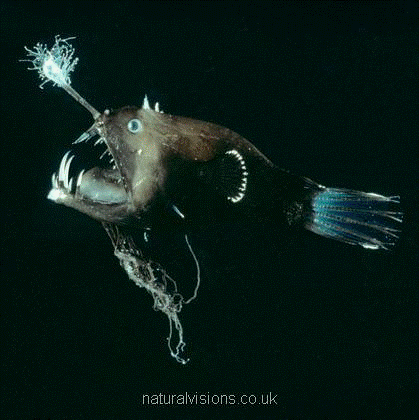
Figure 2:
Linophryne polypogon, an anglerfish species with two bioluminescent systems; a bacterial
symbiont in its lure and an innate system in its chin barbell.
Source.
Functions
Since bioluminesce evolved independently multiple times, it is not hard to believe that light
emission has multiple functions. Different species can use the feature for different effects and
one organism can also use it for different objectives.
One of the more obvious functions of luminescence is communication. Since bioluminescence is
the only source of light in the deep sea, it is easy to imagine they use this light for
communication. It is also possible that different species use different wavelengths of light to
communicate with organisms of the same species(2). Furthermore, fireflies use
bioluminescence in their mating ritual(2,4).
Defence and offence
Bioluminescence can also be used by prey for defence. In the sea, a bright flash at close range
is used to scare predators(2),or to attract other, bigger predators which will attack the first
attacker and will give the prey an opportunity to escape(4). Some startled bioluminescent prey
species can excrete glowing substances into the water, while they get away. The predator is
now blinded by the ‘smoke screen' and unable to proceed its chase(2,4). Additionally, some
organisms are observed to illuminate a part of their body and sacrifice this part to distract
predators(2). Another way of defence is counterillumination, where organisms match their
luminescence with the dim light from above, to remove their shadow. It has also been shown
that luminescence can be a display of toxicity, in the same way bright colours advertise this in
organisms such as the toxic poison dart frogs. All of these examples are displayed in figure 3A. Bioluminescence can also be used by predators. For example, some anglerfish species have an
antenna-shaped organ of which the tip lights up, to attract smaller predators which think they
are in for an easy snack. Other strategies for predators are to stun prey by sending out a bright
flash or to illuminate prey so that they are easier to find(2,4). These tactics are displayed in
figure 3B.
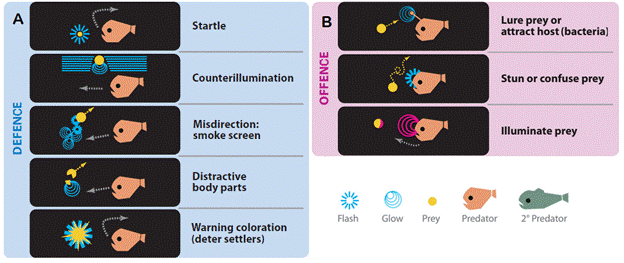
Figure 3:
Different tactics which bioluminescent marine organisms use for defence (A) or
offence (B). Altered from source by Jessy Hollander
Other funcions
The symbiotic relation between bacteria and certain marine animals is often a mutualistic one.
The bacteria provide light that can be used by the host for one of the abovementioned functions,
and the hosts provide a suitable habitat for the bacteria(4).
In terrestrial fungi, bioluminescence is probably used as a way to attract animals that are able to
disperse the spores of the fungi more widely than the wind. It has been shown for one illuminant
fungal species that their light is brighter when more water is available. Since the availability of
water is crucial for the development of the fungi, this means their spores will have a greater shot
at being deposited in an optimal growing environment(8). Figure 4 shows a bioluminescent
fungus.
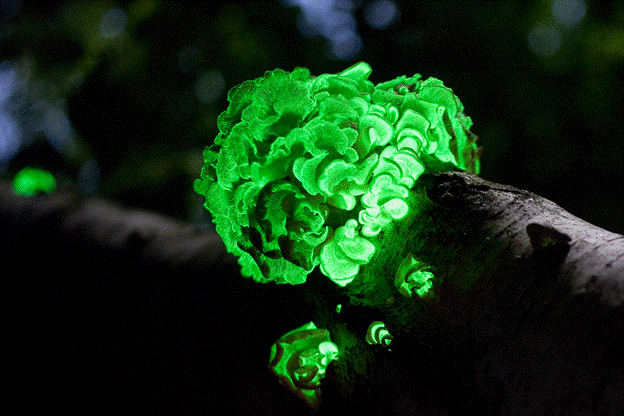
Figure 4:
Bioluminescent fungus, Panellus Stipticus, Ylem (2009).
Source.
Urban uses
It seems like there is no trace of bioluminescent organisms in the urban environment, and you
are right, there are not many. Furthermore, if it is up to some bioengineers, we will be seeing
more of them in the urban environment. There is a lot of research focusing on the practical use
of bioluminescence. One of the most obvious practical purposes would be bioluminescent
organisms used to illuminate urban and domestic environments. Since there aren't many
naturally occurring bioluminescent organisms in the city, they have to be placed into such an
environment. This can be done by relocating the organisms or by genetically engineering native
species to produce light.
Natural occurring bioluminescent species
An example of a species that has been relocated into an urban environment are bioluminescent
bacteria, which are used as a bio-light. Philips used these bacteria in their Microbial Home
system. The bacteria are placed in glass structures where they feed on household waste in the
form of methane gas. In this way they are a very eco-friendly light source(9). Although this
concept will not be commercially produced and sold, it is a good example of how bioluminescent
organisms can enrich and light up our environment.
The Dino Pet by Yonder biology is another example, which is already available for sale. It is
especially designed for children as an interactive nightlight and pet. The Dino Pet is a plastic
container shaped like a dinosaur, filled with bioluminescent dinoflagellates(10) (Figure 5).
Dinoflagellates are one of the most encountered bioluminescent organisms. They can be seen
lighting up the sea in harbors and at beaches(2). When the Dino Pet is placed near a light
source, the dinoflagellates are able to grow. In the dark,
green glow if you shake the container(10).
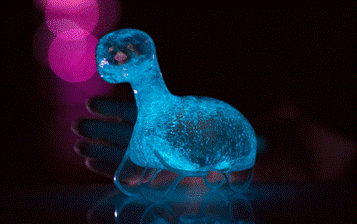
Figure 5:
The Dino Pet, a dino-shaped flask filled with water and dinoflagellates. When shaken,
the dinoflagellates will become bioluminescent.
Source.
The bacterium Vibrio fischeri, one of the best researched bioluminescent species, was used in
an interdisciplinary art and science project called Bioglyphs. The bacteria were plated out on
petri dishes in different patterns and placed in a particular pattern on the wall, creating a glowing
piece of art(11) (Figure 6).
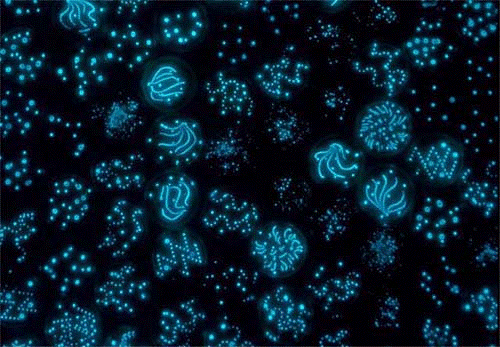
Figure 6:
An example of one of the art pieces from the bioglyphs project.
Source.
All these organisms already had the ability to produce light before they were given a specific
purpose by humans. Because it is possible to alter an organism's genome, we are not restricted
to naturally occurring bioluminescent species. Species that are already able to produce light can
be modified to make them manageable to mankind. For instance, a different promoter can be
used for the bioluminescence gene. The promoter could be sensitive to all kinds of
environmental stimuli like light, the absence of light, temperature, pH or certain chemical
compounds. This is the case in so-called biological biosensors, which means that organisms
can be used as a bioassay. A bioassay is a way of measuring the presence and sometimes the
amount of specific compounds, like environmental pollutants. When, for example, a copper
specific promoter is used for the bioluminescence gene, and we place the gene with this
promoter in Escherichia coli, these bacteria will produce light in the presence of copper and by
doing this, toxic or polluting compounds can be detected. This can be done for water, soil and
air samples as well and is very topical in a world where urbanisation is one of the biggest
causes of pollution(12).
Urban communication
As we shall see, it is possible to create new bioluminescent species out of species that
previously could not produce light. We can therefore create new functions for engineered light
emitting species. Since light is a very common form of communication, light emitting organisms
could as well be used as a form of urban communication. For instance, genetically modified
bioluminescent bacteria could be used as traffic or information sign(9). The organisms can be
grown in a transparent container filled with growth-promoting medium. If you would place an
overlay on top of the container, it is possible to transfer a message, like the fire exit sign shown
in figure 7(9,13). The growth-promoting medium will have to be optimised, so the bacteria
colony can survive for a longer time while on the plate.

Figure 7:
This sign is plated with a genetically modified strain of the bacterium Escherichia coli,
which before was not able to glow, but can also be plated with natural occurring bioluminescent
organisms.
Source.
Informational signs of this type could be very useful in low-light environments like theatres or
cinemas(9). They could also be used in case of a power outage as emergency lighting, lining
the path to the emergency exit, for this type of lighting is not dependent on electricity.
Unfortunately, over a longer period of time the maintenance of optimum growth conditions is
more expensive than the energy this solution saves; it's a false economy. Engineering the
bacteria in such a way that they feed on pollutants, might be a solution.
Light emitting plants
Also, no known plant was capable of luminescence, so scientists took the opportunity to
produce light emitting plants. The first plant that could produce light was a tobacco plant.
Tobacco plants are so-called model organisms, which means they are frequently used in
scientific experiments and are very well-studied. This makes it easier to alter their genome. A
gene coding for the luciferase of a bacterium was inserted into the plant genome. If luciferin was
added, the plant could produce light(5). After that, several other research groups attempted to
make light emitting plants, which did not require the addition of a luciferase. After a few years,
light-producing plants became commercially viable and it is now possible to purchase them (14).
The Starlight Avatar is a bioluminescent plant developed by Bioglow (Figure 8). This company is
currently developing a plant with brighter light and different colours. The Starlight Avatar is quite
small, so it is suitable for domestic environments.
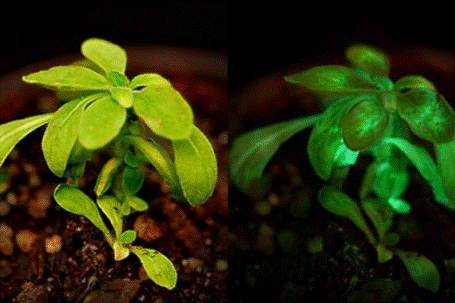
Figure 8:
The Starlight Avatar, developed by Bioglow. One of the first bioengineered
bioluminescent plants that are available for sale.
Source.
Efficiency
Even though a bioluminescent tree will never be as bright as the currently used streetlights(5),
it is something that should be considered, especially when you look at the efficiency of the
process. This manner of light production has an efficiency of around 80%. The other 20 % is
wasted as heat, which means that this is a very efficient reaction(5). Another way of making the
trees more efficient, is by making sure that only the visible parts of the plant are able to produce
light. By using a promoter that is only switched on in the aboveground parts of the plants, no
energy is wasted on the roots. Time as well as location can be programmed, which enables the
plant only to glow when it is night time. For a more aesthetic effect, it is possible to use genes
from different species to produce several colours. This can also be done for other organisms
than trees(5).
Ecological consequences
Since there are not a lot of large woody model plants, there have not yet been experiments
involving taller bioluminescent plants, which can be used as eco-friendly street lights or
christmas trees that glow by themselves(5). Smaller luminescent bushes could be planted next
to the road to mark the edge of the road at night(9). Because it is already possible to let smaller
plants glow, it is assumed that this is possible in larger, woody plants as well. Those plants,
however, would serve a different purpose and ecological as well as ethical concerns should be
considered. In a domestic environment, like that of the Starlight Avatar, there is a finite space,
but if one would place a large bioluminescent tree in the streets, it could affect a larger area and
its inhabitants. It is already known that some animals like birds, toads and moths behave
differently in the vicinity of artificial light(15). Sometimes, predator-prey relations or scavenging
behaviour can be influenced by artificial lighting. If we take a bioluminescent tree that functions
as a street light, for example, it might also interfere with the behaviour of such animals. It is
important to prevent the tree from spreading to places it isn't intended to and become an
invasive species(5). Other unforeseen consequences are a concern as well. Therefore
spreading through the environment must be counteracted.
Precautions
Several precautions must and can be taken to prevent environmental damage. To show how we
can interfere as little as possible with the environment, let us look again at the example of the
bioluminescent street light. First of all it has been shown that not naturally occurring
bioluminescent organisms are less fit than their non-bioluminescent counterparts. This means
they are less likely to have as many and healthy progeny. These trees are therefore unlikely to
outcompete other species or their own species. This, of course, would only happen if the plant
could reproduce, but since it is possible to use infertile plants, competition between other plant
is undermined. Another way of accomplishing this, is the use of plastids as a barrier. It is
possible to implement the genes coding for luminescence in the plastid DNA. Since plastids are
maternally inherited, the pollen, which are paternal cells, do not contain any plasmids. This
means the bioluminescence gene will not spread through the pollen. Another method to contain
the genetically altered organism in its intended environment is the use of auxotrophic organisms
. Auxotrophy means that an organism is dependent on a certain chemical compound. Usually
the organism is perfectly capable of producing this substance itself. Through inducing a
mutation in the gene that encodes the production machinery for this substance, the organism
now lacks this crucial compound. Because the organism will die in the absence of the chemical,
it is now dependent on the administration of the vital compound(5). The tree from our example
is only able to grow if the compound is present and is therefore unable to spread through the
environment. Containment is in addition to ethical issues the biggest reason why most
genetically engineered species are not widely accepted in the western world. In fact, there are a
lot of restrictions imposed on their use and even prohibited in Europe. But this doesn't mean we
cannot dream.
Conclusion
Bioluminescence is a widespread phenomenon that has evolved independently multiple times.
Because this way of producing light does not need electricity it is interesting to look at different
ways of using this property to our advantage, for instance by using them to light up emergency
exit signs, as a form of art, or as a night light. Up until now, the practical uses were limited to
using organisms that have naturally occurring bioluminescence. The use of genetically modified
organisms is still not accepted in a lot of countries. Until then we can enjoy our light emitting
friends in glass containers. And maybe you can come up with some bright ideas to use
bioluminescence yourself!
You might also enjoy:
- Watch a TED talk about different bioluminescent marine species, it gives a good
indication of what bioluminescence does for deep sea creatures.
- Visit this site to experience a coral reef at night from behind your computer and learn a
lot more about bioluminescence in the sea.
- Read this news article for more applications of bioluminescence in our everyday life.
- Read this article for a lot more background information about bioluminescence in the
sea.















